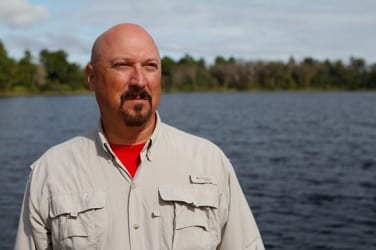Sunscreen’s Hidden Hazards
Lathering up with sunscreen may prevent sunburn and protect against cancer, but it is also killing coral reefs around the world.
That’s the conclusion of a team of international scientists, which includes UCF associate professor of biological sciences and diving enthusiast John Fauth, Ph.D.
The researchers found that oxybenzone, a common UV-filtering compound, is in high concentrations in the waters around the more popular coral reefs in Hawaii, and the Caribbean. The chemical not only kills the coral, it causes DNA damage in adults and deforms the DNA in coral in the larval stage, making it unlikely they can develop properly. The highest concentrations of oxybenzone were found in reefs most popular with tourists.
“Coral reefs are the world’s most productive marine ecosystems and support commercial and recreational fisheries and tourism,” Fauth said. “In addition, reefs protect coastlines from storm surge. Worldwide, the total value of coral reefs is tremendous. And they are in danger.”
The team’s findings are published in today’s edition of the journal Archives of Environmental Contamination and Toxicology.
Executive director and researcher Craig Downs of the non-profit scientific organization Haereticus Environmental Laboratory in Virginia led the team. The scientists collected samples from reefs in Hawaii, the U.S. Virgin Islands and Eilat, Israel diving into the water themselves. They wore no personal hygiene products during the dives.
“The use of oxybenzone-containing products needs to be seriously deliberated in islands and areas where coral reef conservation is a critical issue,” Downs said. “We have lost at least 80 percent of the coral reefs in the Caribbean. Any small effort to reduce oxybenzone pollution could mean that a coral reef survives a long, hot summer, or that a degraded area recovers. Everyone wants to build coral nurseries for reef restoration, but this will achieve little if the factors that originally killed off the reef remain or intensify in the environment.”
In laboratory experiments, the team exposed coral larvae and cells of adult corals to increasing concentrations of oxybenzone. The research team discovered that oxybenzone deforms coral larvae by trapping them in their own skeleton, making then unable to float with currents and disperse.
Oxybenzone also caused coral bleaching, which is a prime cause of coral mortality worldwide. Corals bleach when they lose or expel the algae that normally live inside them, thus losing a valuable source of nutrition. In addition, coral larvae exposed to increasing oxybenzone concentrations suffered more DNA damage.
Cells from seven species of corals were killed by oxybenzone at concentrations similar to those detected in ocean water samples. Three of the species that the researchers tested are currently listed as threatened under the US Endangered Species Act.
The team concluded in the published paper that “Oxybenzone poses a hazard to coral reef conservation, and threatens the resiliency of coral reefs to climate change.”
Others on the research team included scientists from Haereticus Environmental Laboratory; the U.S. National Oceanic and Atmospheric Administration; the National Aquarium in Baltimore; the University of Hawaii; and Tel Aviv University and Ben-Gurion University of the Negev, Israel.
So what can everyday divers do to protect the reefs?
“Wear rash guards or scuba wetsuits and skip all the hygienic products when you go diving,” Fauth said. “If we could do it for a week at a time, people can certainly forgo it for a few hours to help protect these reefs for our children and their children to see.”
Click here to read original story.
Also read the story here at: http://www.washingtonpost.com/news/energy-environment/wp/2015/10/20/after-sunscreen-protects-humans-it-massacres-coral-reefs/

